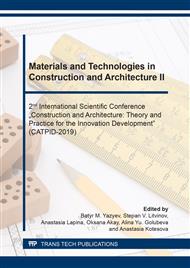[1]
N.I. Alfimova, S.Yu. Pirieva, D.V. Gudov, I.M. Shurakov, Е.Е. Korbut, Optimization of receptural-technological parameters of manufacture of cellular concrete mixture, Construction Materials and Products. 1 (2) (2018) 30–36.
DOI: 10.34031/2618-7183-2018-1-2-30-36
Google Scholar
[2]
L.Kh. Zagorodnyuk, V.S. Lesovik, D.A. Sumskoy, Thermal insulation solutions of the reduced density, Construction Materials and Products. 1 (1) (2018) 40–50.
DOI: 10.34031/2618-7183-2018-1-1-40-50
Google Scholar
[3]
M.Yu. Elistratkin, M.I. Kozhukhova, Analysis of the factors of increasing the strength of the non-autoclave aerated concrete, Construction Materials and Products. 1 (1) (2018) 59–68.
DOI: 10.34031/2618-7183-2018-1-1-59-68
Google Scholar
[4]
T.V. Anikanova, A.S. Pogoromsky. The use of semi-aquatic calcium sulfate to intensify the processes of hardening of structural heat-insulating foamed concrete, Construction Materials and Products. 1 (3) (2018) 25–32.
DOI: 10.34031/2618-7183-2018-1-3-25-32
Google Scholar
[5]
E.V. Fomina, V.V. Strokova, M.I. Kozhukhova, Effect of previously slacked lime on properties of autoclave composite binders, World Applied Sciences Journal. 24 (11) (2013) 1519-1524.
Google Scholar
[6]
A. Mestnikov, S. Semenov, V. Strokova, V. Nelubova, Autoclave foam concrete: Structure and properties, AIP Conference Proceedings. (2016), 1698.
DOI: 10.1063/1.4937880
Google Scholar
[7]
A.N. Volodchenko, V.V. Strokova, Features of the technology for obtaining structural heat insulating cellular concrete based on nonconventional raw materials, Bulletin of BSTU named after V.G. Shukhov. 1 (2017) 138-143.
DOI: 10.12737/24193
Google Scholar
[8]
A.N. Volodchenko, Development of the composition of heat-insulating materials for autoclaved hardening based on clay raw materials, Bulletin of BSTU named after V.G. Shukhov. 2 (2017) 162-167.
DOI: 10.12737/24452
Google Scholar
[9]
A.N. Volodchenko, Aluminosilicate raw materials for the production of autoclave finishing materials, Bulletin of BSTU named after V.G. Shukhov. 2 (2017) 172-177.
DOI: 10.12737/24429
Google Scholar
[10]
N.V. Pavlenko, V.V. Strokova, M.N. Kapusta, D.D. Netsvet, About application prospectivity of rocks with different geological and morphological features as basic raw component for free-cement binder production, Applied Mechanics and Materials. 670-671 (2014) 462-465.
DOI: 10.4028/www.scientific.net/amm.670-671.462
Google Scholar
[11]
V. Nelyubova, N. Pavlenko, D. Netsvet, Cellular composites with ambient and autoclaved type of hardening with application of nanostructured binder, IOP Conference Series: Materials Science and Engineering. 96 (2015) (1).
DOI: 10.1088/1757-899x/96/1/012010
Google Scholar
[12]
Ovcharenko, G.I., Gilmiyarov, D.I. Strength and phase composition of autoclaved material: an approximation. Magazine of Civil Engineering. 83 (7) (2018) 63–72.
Google Scholar
[13]
V.V. Nelyubova, M.N. Sivalneva, D.O. Bondarenko, P.S. Baskakov, Study of activity of polydisperse mineral modifiers via unstandardized techniques, Journal of Physics: Conference Series. 1118 (2018) (1).
DOI: 10.1088/1742-6596/1118/1/012029
Google Scholar


